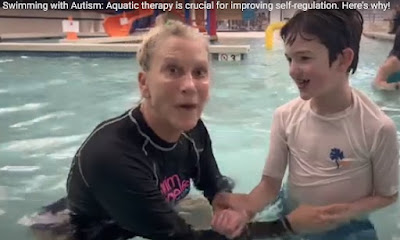Swimming with Autism: Aquatic Therapy
Aquatic therapy is a form of physical therapy that takes place in a pool or other aquatic environment. It is designed to help individuals with a wide range of conditions, including Autism, improve their motor function, strengthen muscles, and improve overall physical fitness. However, aquatic therapy has some unique benefits for children with Autism. This article and video below, explain that the three key elements of water - hydrostatic pressure, viscosity, and surface tension - work together to support therapy goals for children with Autism.
 |
| Swimming with Autism |
Hydrostatic pressure provides a calming effect and can help reduce anxiety and stress. Viscosity creates resistance, which can help strengthen muscles and improve motor control. Surface tension can create a gentle massaging effect, which can be soothing for children with Autism. These properties of water, combined with specific handling techniques by trained aquatic therapists, can prove to be a magical recipe for improvements in self-regulation, motor control, and water safety.
This article and video below also highlight the potential impact of aquatic therapy on speech therapy. Some children with Autism have limited vocalisations, but aquatic therapy can help improve oral motor skills that relate to speech. Children can practice blowing bubbles and controlled airflow, which can strengthen the muscles around the rib cage and make deeper breathing patterns easier. As a result, some children show an increase in vocalisations and verbal communication after aquatic therapy.
In summary, aquatic therapy is a unique and valuable form of therapy for children with Autism. It can help them improve their self-regulation, attention, motor control, and speech skills, as well as teach them crucial water safety skills. The calming effect of the water, combined with the resistance and massaging effect, creates an environment that can help children with Autism achieve therapy goals faster and more effectively.
Enjoy
Richard







No comments:
Post a Comment